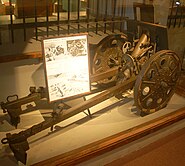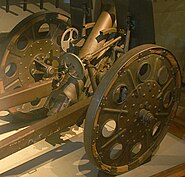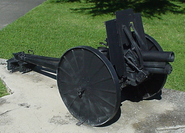| 70 mm Type 92 battalion gun | |
|---|---|
 A Type 92, without shield, at the U.S. Army Field Artillery Museum, Ft. Sill, OK | |
| Type | Howitzer |
| Place of origin |
|
| Service history | |
| In service | 1932-1945 |
| Used by |
|
| Wars |
Second Sino-Japanese War Soviet-Japanese Border Wars World War II |
| Specifications | |
| Mass | 216 kg (476 lbs) |
| Length | 2,006 mm (6 ft 7 in) |
| Barrel length | 723 mm (2 ft 4 in) |
| Width | 914 mm (3 ft) |
| Height | 775 mm (2 ft 7 in) |
| Crew | 5 |
|
| |
| Shell | separate-loading |
| Caliber | 70mm (2.75 in) |
| Breech | interrupted thread, drop breechblock |
| Recoil | hydro-spring |
| Carriage | split-trail |
| Elevation | -4° to +70° |
| Traverse | 45° |
| Rate of fire | 10 rpm |
| Muzzle velocity | 198 m/s (650 ft/s) |
| Effective firing range | 2,785 m (3,060 yards) |

Type 92 battalion gun captured by USMC on Saipan

Type 92 battalion gun captured on Guadacanal
The Type 92 battalion gun (九二式歩兵砲 Kyūni-shiki Hoheihō) was a light howitzer used by the Imperial Japanese Army during the Second Sino-Japanese War and World War II.[1] The Type 92 designation was for the year the gun was accepted, 2592 in the Japanese imperial year calendar, or 1932 in the Gregorian calendar.[2] Each infantry battalion included two Type 92 guns; therefore, the Type 92 was referred to as "battalion artillery" (大隊砲 Daitaihō).
History and development[]
The Type 92 battalion gun was designed in response to issues with the Type 11 37 mm infantry gun and the Type 11 70 mm infantry mortar. Both lacked sufficient firepower and range, and infantry divisions did not like the fact that they had to carry two different types of weapons with different ammunition into combat. As a result, the army technical bureau developed a design which could be used either at low angle direct fire to take out fortified positions, machine gun nests and light armor, but also could be used at high angle indirect support fire. The caliber of the new weapon was increased to 70 mm to address the issue of inadequate firepower. The new design was available to front line divisions by 1932.[3]
Design[]
Somewhat unusual in appearance, the Type 92 battalion gun had a short gun barrel with a split trail carriage. The barrel could be configured from a horizontal to near vertical position with a hand-crank. It had an interrupted thread type, drop breechblock mechanism. Lightweight and maneuverable, it was designed to be pulled by a single horse, although in practice teams of three horses were usually assigned. The wheel were originally wooden, but were changed to steel after troops complained that the noise from the squeaky wooden wheels was a threat.[4]
The Type 92 battalion gun could fire high-explosive shells (3.795 kg (8.37 lb)), armor-piercing, and smoke rounds. The propellant was semi-fixed, and could be loaded in four increments to adjust range.[5]
Combat record[]
The Type 92 battalion gun was first used in combat during the Manchurian Incident, and was subsequently in heavy use throughout the invasion of Manchuria, the Battle of Nomonhan and subsequent Second Sino-Japanese War. It later accompanied units assigned to the Pacific front and was used with considerable effectiveness against Allied forces throughout the South Pacific Mandate and in Southeast Asia.
Significant quantities of Type 92 guns remained in China following the cessation of hostilities in 1945, and were taken into service by the People's Liberation Army, which also manufactured ammunition for them, retaining the Type 92 nomenclature. US Department of the Army Pamphlet 381-12, "Recognition Guide of Ammunition Available to, or in Use by, the Viet Cong, dated May 1966, includes Chinese 70mm Type 92 ammunition.
Surviving examples[]
Two guns are preserved on display in a small park on Main Street in Lakeport, California. The southern gun serial number 399, has unperforated sheet metal wheels, while the wheels of the northern gun appear to have been restored with new material. Another gun displayed in front of the Veterans Hall in Arcata, California has serial number 136 and was made at the Osaka Infantry Armory.[6]
References[]
Notes[]
- ↑ Bishop, The Encyclopedia of Weapons of World War II
- ↑ War Department TM-E-30-480 Handbook on Japanese Military Forces September 1944 p 400
- ↑ McLean. Japanese Artillery; Weapons and Tactics
- ↑ Japanese Wikipedia article
- ↑ Chamberlain, Light and Medium Field Artillery
- ↑ Felter, Bob. "Arcata"s Cannon". Humboldt Historian, Winter 2012 Volume 60 Number 4
Bibliography[]
- War Department TM-E-30-480 Handbook on Japanese Military Forces September 1944
- Bishop, Chris (eds) The Encyclopedia of Weapons of World War II. Barnes & Nobel. 1998. ISBN 0-7607-1022-8
- Chamberlain, Peter and Gander, Terry. Light and Medium Field Artillery. Macdonald and Jane's (1975). ISBN 0-356-08215-6
- Chant, Chris. Artillery of World War II, Zenith Press, 2001, ISBN 0-7603-1172-2
- McLean, Donald B. Japanese Artillery; Weapons and Tactics. Wickenburg, Ariz.: Normount Technical Publications 1973. ISBN 0-87947-157-3.
- US Department of War, TM 30-480, Handbook on Japanese Military Forces, Louisiana State University Press, 1994. ISBN 0-8071-2013-8
- Felter, Bob. "Arcata"s Cannon". Humboldt Historian, Winter 2012 Volume 60 Number 4
External links[]
Gallery[]
Notes[]
The original article can be found at Type 92 battalion gun and the edit history here.







